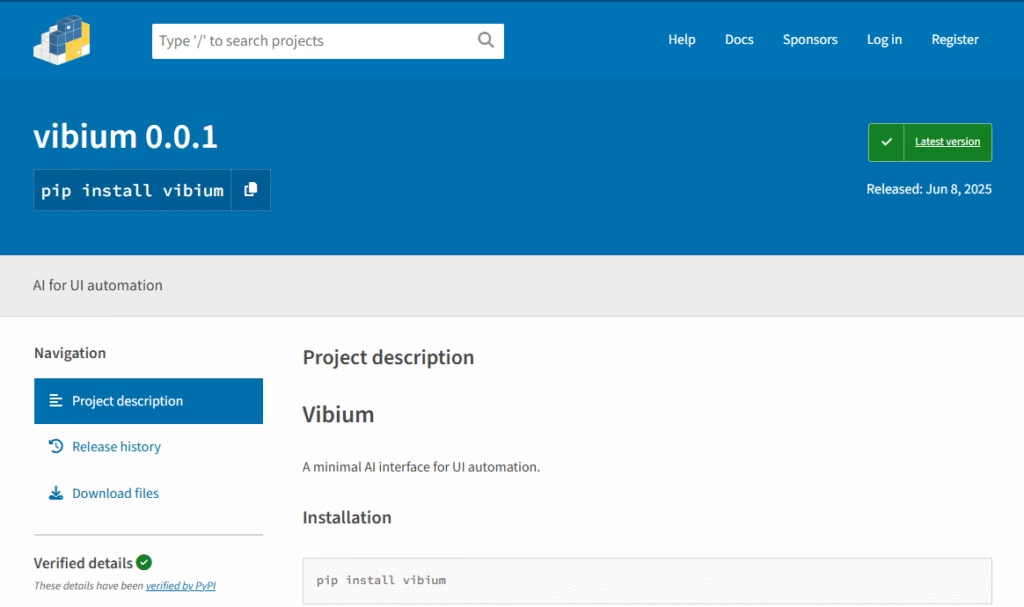In the rapidly evolving world of test automation, Vibium represents the next generation of AI-native browser automation. Created by Jason Huggins, the visionary behind Selenium and Appium, Vibium addresses the chronic pain points that have plagued QA teams for years: flaky tests, brittle locators, and overwhelming maintenance overhead.
Unlike traditional automation frameworks that require extensive coding expertise, Vibium empowers teams to write tests in plain English while leveraging artificial intelligence to create self-healing, adaptive test suites. This revolutionary approach promises to transform how organizations approach test automation in 2025 and beyond.

What Makes Vibium Different from Selenium and Playwright?
The AI-Native Advantage
Vibium stands apart from its predecessors through its AI-first architecture designed specifically for modern web applications. While Selenium requires manual locator management and Playwright focuses on speed and reliability, Vibium combines the best of both worlds with intelligent automation capabilities.
Key Differentiators
Plain English Test Writing: Teams can describe test scenarios using natural language instead of complex code structures. For example, instead of writing driver.findElement(By.id("login-button")).click(), you simply write “Click the login button”.
Self-Healing Capabilities: When UI elements change, Vibium automatically adapts test scripts without manual intervention. This addresses one of the biggest challenges in test automation maintenance.
WebDriver BiDi Protocol: Built on the next-generation browser automation standard, Vibium offers faster and more stable execution compared to traditional WebDriver implementations.
Essential Prerequisites for Getting Started
System Requirements
Before diving into Vibium, ensure your development environment meets these requirements:
- Node.js 16+ or Python 3.8+ for CLI operations
- Modern browsers: Chrome 90+, Firefox 88+, or Edge 90+
- Operating System: Windows 10+, macOS 10.15+, or Linux Ubuntu 18.04+
- Memory: Minimum 8GB RAM (16GB recommended for parallel execution)
Development Environment Setup
IDE Recommendations: Visual Studio Code with Vibium extension (whenever launched), IntelliJ IDEA, or any text editor with syntax highlighting support for your preferred language.
Version Control: Git integration is essential for tracking test script evolution and collaboration across teams.
Step-by-Step Installation Guide
Installing Vibium CLI
The quickest way to get started is through the command-line interface:
# For Node.js environments
npm install -g vibium-cli
# For Python environments
pip install vibiumVerifying Installation
Confirm successful installation by checking the version:
vibium --versionCreating Your First Project
Initialize a new Vibium project with automated configuration:
init my-first-project
cd my-first-projectThis command creates a project structure with sample test files, configuration templates, and best practice examples.
Writing Your First Vibium Test
Basic Test Structure
Vibium tests follow an intuitive, conversational format that mirrors how humans describe user interactions:
Feature: User Login Functionality
Scenario: Successful login with valid credentials
Given I navigate to "https://qawebsite.com/login"
When I enter "testuser@email.com" in the email field
And I enter "SecurePass123" in the password field
And I click the "Login" button
Then I should see "Welcome Dashboard" on the pageAdvanced Test Scenarios
For more complex workflows, Vibium supports conditional logic and data-driven testing:
Scenario: E-commerce checkout process
Given I am logged in as a premium customer
When I add "MacBook Pro" to shopping cart
And I proceed to checkout
And I select "Express Shipping" option
Then the total should include express shipping fee
And I should see estimated delivery within 2 daysReal-World Implementation: Hypothetical Scenarios
Industry Context
Self-Healing Automation Benefits: Research on self-healing test automation shows potential for 60-80% reduction in test maintenance effort, which provides context for what tools like Vibium might achieve.
AI-Native Testing Trends: The broader industry is moving toward AI-powered testing solutions, with Vibium positioning itself at the forefront of this transformation.
Hypothetical QA Team Transformation
Scenario: A mid-sized SaaS company with 50 automated tests experiencing daily maintenance overhead could potentially see significant improvements after migrating from Selenium to Vibium. Based on general self-healing automation benefits, such a team might expect:
- Reduced test maintenance time through AI-powered self-healing capabilities
- Fewer false positives from UI changes due to adaptive locator strategies
- Increased team focus on exploratory testing and feature coverage
Note: These are projected benefits based on self-healing automation research, not verified Vibium case studies.
Hypothetical Enterprise Adoption
Scenario: A large financial services company implementing AI-native test automation across multiple teams could theoretically achieve:
- Faster test execution through optimized element identification
- Reduced maintenance overhead from brittle test scripts
- Improved test coverage with simplified test creation process
Disclaimer: These represent potential benefits based on AI automation research, not actual Vibium implementation data.
Available Real Information About Vibium
Confirmed Details from Research
Creator and Vision: Jason Huggins, founder of Selenium and Appium, launched Vibium as an “AI-native successor to Selenium”. The tool aims to address chronic pain points in test automation: flaky tests, brittle locators, and maintenance overhead.
Core Features: Based on available information:
- Plain English test scripting capabilities
- Self-healing test functionality to adapt to UI changes
- WebDriver BiDi protocol implementation for modern browser automation
- Initial support for JavaScript/TypeScript environments
Community Interest: The tool has generated significant discussion in QA communities, with professionals expressing interest in its potential to modernize test automation practices.
Current Status: As of September 2025, Vibium appears to be in early stages with demonstrations and community building underway, though specific adoption metrics or detailed case studies are not yet publicly available.
Advanced Configuration and Optimization
CI/CD Pipeline Integration
Vibium seamlessly integrates with modern DevOps workflows:
# GitHub Actions example
- name: Run Vibium Tests
run: |
vibium test --parallel --browser chrome,firefox
vibium report --format junit
Parallel Test Execution
Scale your testing with intelligent parallel execution:
test --parallel --workers 4 --distribute-by feature
Cross-Browser Testing Configuration
Configure multi-browser testing for comprehensive coverage:
{
"browsers": ["chrome", "firefox", "safari", "edge"],
"viewports": ["desktop", "tablet", "mobile"],
"environments": ["staging", "production"]
}
Comparison: Vibium vs Traditional Tools
Best Practices for Vibium Success
Test Design Principles
Focus on User Journeys: Write tests that mirror actual user behavior rather than technical implementation details.
Maintain Test Independence: Each test scenario should run independently without dependencies on other tests.
Use Descriptive Naming: Clear, descriptive test names improve maintainability and team collaboration.
Optimization Strategies
Leverage AI Suggestions: Vibium’s AI engine should provide optimization recommendations—implement them to improve test reliability.
Monitor Test Performance: Regular performance analysis helps identify bottlenecks and optimization opportunities.
Implement Progressive Enhancement: Start with core functionality tests and gradually add complex scenarios.
Troubleshooting Common Issues
Element Identification Problems
When Vibium struggles with element identification, use explicit descriptors:
Instead of: "Click button"
Use: "Click the blue 'Submit Order' button in the checkout section"
Test Flakiness Resolution
Most flakiness issues resolve automatically through self-healing, but you can help by:
- Using stable, descriptive element identifiers
- Adding appropriate wait conditions for dynamic content
- Avoiding time-dependent assertions
Performance Optimization
For slow test execution:
- Enable parallel execution for independent test suites
- Use browser reuse between related test scenarios
- Optimize test data preparation and cleanup
Frequently Asked Questions
What makes Vibium better than Selenium for test automation?
Vibium offers AI-native architecture with self-healing capabilities, eliminating the brittle locator issues that plague Selenium. Tests written in plain English are more maintainable and accessible to non-technical team members.
How does Vibium handle dynamic web applications?
Vibium’s AI engine will aadapt automatically to UI changes, using machine learning to identify renamed elements, repositioned components, and structural modifications without manual script updates.
Can Vibium integrate with existing CI/CD pipelines?
Yes, Vibium should provide native integrations with Jenkins, GitHub Actions, GitLab CI, Azure DevOps, and other popular CI/CD platforms. The CLI supports standard output formats for seamless pipeline integration.
What programming languages does Vibium support?
Vibium should ideally support JavaScript, TypeScript, and Python, with Java and C# support planned for future releases. The plain English syntax reduces language barrier concerns significantly.
Is Vibium suitable for mobile app testing?
While Vibium focuses primarily on web browser automation, mobile web testing should be fully supported. Native mobile app testing capabilities might be under development for future releases.
How does the self-healing feature actually work?
Vibium’s self-healing may use machine learning algorithms to analyze DOM structure, element attributes, and visual characteristics. When original locators fail, it should intelligently identify alternative selectors and updates test scripts automatically.
What’s the learning curve for teams switching from Selenium?
Teams typically achieve basic proficiency within 2-3 weeks due to the plain English syntax. Advanced features and optimization techniques require additional 4-6 weeks for full mastery.
Does Vibium work with legacy web applications?
Vibium would support modern web standards and protocols. While it would work with many legacy applications, sites using outdated frameworks or non-standard implementations may require custom configuration.
Future of Test Automation with Vibium
Industry Adoption Trends
The shift toward AI-native testing tools reflects broader industry recognition that traditional automation approaches cannot keep pace with modern development cycles. Organizations investing in AI-powered testing report significant improvements in delivery velocity and software quality.
Competitive Landscape Evolution
As major players integrate AI capabilities, Vibium’s first-mover advantage in AI-native architecture positions it as a leader in the next generation of test automation tools.
Technology Roadmap
Future Vibium releases may include enhanced visual testing, API test integration, and predictive test maintenance capabilities based on machine learning analysis of application changes.
Official Resources
Conclusion: Transform Your Testing with Vibium
Vibium represents more than just another test automation tool—it’s a paradigm shift toward intelligent, maintainable, and truly scalable testing. By embracing AI-native architecture and plain English scripting, teams can finally break free from the maintenance burden that has historically limited automation ROI.
The combination of self-healing capabilities, WebDriver BiDi protocol, and intuitive test authoring positions Vibium as the clear choice for organizations serious about modernizing their QA processes. As the testing landscape continues evolving, early adopters of AI-powered automation will gain significant competitive advantages in delivery speed and software quality.
Ready to revolutionize your test automation strategy? Start exploring Vibium today and join the growing community of QA professionals embracing the future of intelligent testing. Share your Vibium experiences in the comments below and help fellow testers discover the power of AI-native automation.
Explore more cutting-edge QA insights and automation strategies at QAbash.com—your trusted source for software testing excellence.
QABash Nexus—Subscribe before It’s too late!
Monthly Drop- Unreleased resources, pro career moves, and community exclusives.
